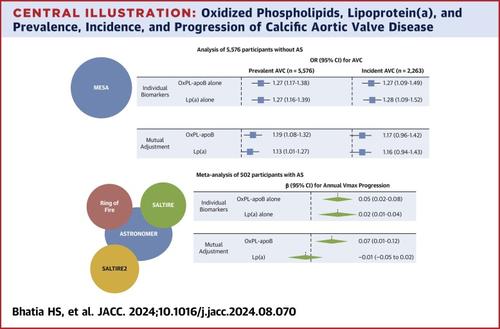当前位置:
X-MOL 学术
›
J. Am. Coll. Cardiol.
›
论文详情
Our official English website, www.x-mol.net, welcomes your
feedback! (Note: you will need to create a separate account there.)
Oxidized Phospholipids and Calcific Aortic Valvular Disease
Journal of the American College of Cardiology ( IF 21.7 ) Pub Date : 2024-11-15 , DOI: 10.1016/j.jacc.2024.08.070 Harpreet S. Bhatia, Marc R. Dweck, Neil Craig, Romain Capoulade, Philippe Pibarot, Patrick J. Trainor, Seamus P. Whelton, Rishi Rikhi, Karita C.F. Lidani, Wendy S. Post, Michael Y. Tsai, Michael H. Criqui, Michael D. Shapiro, Matthew J. Budoff, Andrew P. DeFilippis, George Thanassoulis, Sotirios Tsimikas
中文翻译:

氧化磷脂和钙化性主动脉瓣病
氧化磷脂 (OxPLs) 由含载脂蛋白 B-100 的脂蛋白 (OxPL-apoB) 携带,包括脂蛋白 (a) (Lp[a])。OxPL-apoB 和 Lp(a) 都与钙化性主动脉瓣病 (CAVD) 有关。
本研究旨在评估 OxPL-apoB 、 Lp(a) 与 CAVD 患病率、发病率和进展之间的相关性。
在 MESA(动脉粥样硬化多种族研究)和对 4 项已确诊主动脉瓣狭窄 (AS) 参与者的随机试验的参与者水平荟萃分析中评估了 OxPL-apoB 和 Lp(a)。在 MESA 中,使用多变量顺序回归模型评估基线和 9.5 年时 OxPL-apoB 和 Lp(a) 与主动脉瓣钙 (AVC) 的相关性。在荟萃分析中,使用多变量线性回归模型评估 OxPL-apoB 和 Lp(a) 与 AS 进展 (主动脉瓣峰值射流速度的年化变化) 之间的关联。
在 MESA 中,OxPL-apoB 和 Lp(a) 均与患病率 AVC 相关 (OR per SD: 1.19 [95% CI: 1.07-1.32] 和 1.13 [95% CI: 1.01-1.27]),两者之间存在显着交互作用 (P < 0.01)。单独评估时,OxPL-apoB 和 Lp(a) 均与 9.5 年时发生 AVC 相关 (交互作用 P < 0.01)。OxPL-apoB∗Lp(a) 相互作用表明,随着 Lp(a) 水平的增加,OxPL-apoB 的患病率和新发 AVC 的几率更高。在荟萃分析中,当单独分析时,OxPL-apoB 和 Lp(a) 都与峰值主动脉瓣射流速度的更快增加相关,但当一起评估时,只有 OxPL-apoB 仍然显着 (ß: 0.07;95% CI: 0.01-0.12)。
OxPL-apoB 是 AVC 和已确诊 AS 的存在、发生率和进展的预测因子,尤其是在 Lp(a) 水平升高的情况下,可能代表 CAVD 的新治疗靶点。
更新日期:2024-11-15
Journal of the American College of Cardiology ( IF 21.7 ) Pub Date : 2024-11-15 , DOI: 10.1016/j.jacc.2024.08.070 Harpreet S. Bhatia, Marc R. Dweck, Neil Craig, Romain Capoulade, Philippe Pibarot, Patrick J. Trainor, Seamus P. Whelton, Rishi Rikhi, Karita C.F. Lidani, Wendy S. Post, Michael Y. Tsai, Michael H. Criqui, Michael D. Shapiro, Matthew J. Budoff, Andrew P. DeFilippis, George Thanassoulis, Sotirios Tsimikas

|
Background
Oxidized phospholipids (OxPLs) are carried by apolipoprotein B-100–containing lipoproteins (OxPL-apoB) including lipoprotein(a) (Lp[a]). Both OxPL-apoB and Lp(a) have been associated with calcific aortic valve disease (CAVD).Objectives
This study aimed to evaluate the associations between OxPL-apoB, Lp(a) and the prevalence, incidence, and progression of CAVD.Methods
OxPL-apoB and Lp(a) were evaluated in MESA (Multi-Ethnic Study of Atherosclerosis) and a participant-level meta-analysis of 4 randomized trials of participants with established aortic stenosis (AS). In MESA, the association of OxPL-apoB and Lp(a) with aortic valve calcium (AVC) at baseline and 9.5 years was evaluated using multivariable ordinal regression models. In the meta-analysis, the association between OxPL-apoB and Lp(a) with AS progression (annualized change in peak aortic valve jet velocity) was evaluated using multivariable linear regression models.Results
In MESA, both OxPL-apoB and Lp(a) were associated with prevalent AVC (OR per SD: 1.19 [95% CI: 1.07-1.32] and 1.13 [95% CI: 1.01-1.27], respectively) with a significant interaction between the two (P < 0.01). Both OxPL-apoB and Lp(a) were associated with incident AVC at 9.5 years when evaluated individually (interaction P < 0.01). The OxPL-apoB∗Lp(a) interaction demonstrated higher odds of prevalent and incident AVC for OxPL-apoB with increasing Lp(a) levels. In the meta-analysis, when analyzed separately, both OxPL-apoB and Lp(a) were associated with faster increase in peak aortic valve jet velocity, but when evaluated together, only OxPL-apoB remained significant (ß: 0.07; 95% CI: 0.01-0.12).Conclusions
OxPL-apoB is a predictor of the presence, incidence, and progression of AVC and established AS, particularly in the setting of elevated Lp(a) levels, and may represent a novel therapeutic target for CAVD.中文翻译:

氧化磷脂和钙化性主动脉瓣病
背景
氧化磷脂 (OxPLs) 由含载脂蛋白 B-100 的脂蛋白 (OxPL-apoB) 携带,包括脂蛋白 (a) (Lp[a])。OxPL-apoB 和 Lp(a) 都与钙化性主动脉瓣病 (CAVD) 有关。
目标
本研究旨在评估 OxPL-apoB 、 Lp(a) 与 CAVD 患病率、发病率和进展之间的相关性。
方法
在 MESA(动脉粥样硬化多种族研究)和对 4 项已确诊主动脉瓣狭窄 (AS) 参与者的随机试验的参与者水平荟萃分析中评估了 OxPL-apoB 和 Lp(a)。在 MESA 中,使用多变量顺序回归模型评估基线和 9.5 年时 OxPL-apoB 和 Lp(a) 与主动脉瓣钙 (AVC) 的相关性。在荟萃分析中,使用多变量线性回归模型评估 OxPL-apoB 和 Lp(a) 与 AS 进展 (主动脉瓣峰值射流速度的年化变化) 之间的关联。
结果
在 MESA 中,OxPL-apoB 和 Lp(a) 均与患病率 AVC 相关 (OR per SD: 1.19 [95% CI: 1.07-1.32] 和 1.13 [95% CI: 1.01-1.27]),两者之间存在显着交互作用 (P < 0.01)。单独评估时,OxPL-apoB 和 Lp(a) 均与 9.5 年时发生 AVC 相关 (交互作用 P < 0.01)。OxPL-apoB∗Lp(a) 相互作用表明,随着 Lp(a) 水平的增加,OxPL-apoB 的患病率和新发 AVC 的几率更高。在荟萃分析中,当单独分析时,OxPL-apoB 和 Lp(a) 都与峰值主动脉瓣射流速度的更快增加相关,但当一起评估时,只有 OxPL-apoB 仍然显着 (ß: 0.07;95% CI: 0.01-0.12)。
结论
OxPL-apoB 是 AVC 和已确诊 AS 的存在、发生率和进展的预测因子,尤其是在 Lp(a) 水平升高的情况下,可能代表 CAVD 的新治疗靶点。


















































 京公网安备 11010802027423号
京公网安备 11010802027423号